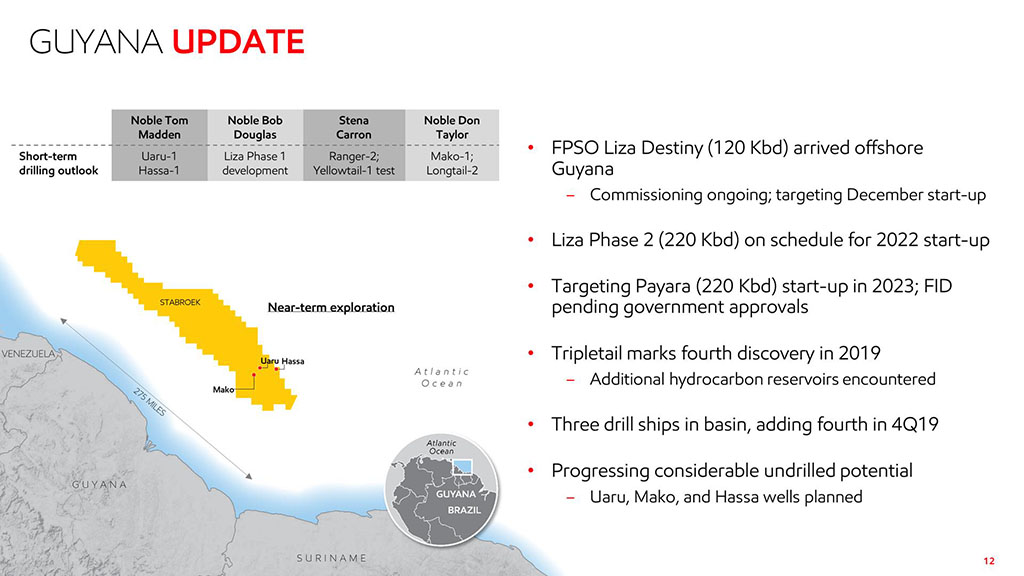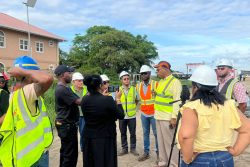With Guyana’s first oil production projected for next month, ExxonMobil yesterday announced that it will begin drilling three additional exploration wells in the Stabroek Block in the coming months, even as the company boasted of its success here during its third quarter earnings call.
“We continue to progress considerable undrilled potential in Guyana…three upcoming wells, Uaru, Mako, and Hassa are planned to spud in the upcoming months,” said ExxonMobil’s Vice President of Investor Relations and Secretary Neil Hansen, who led yesterday’s financial update for the third quarter.
Providing an update on the company’s Guyana operations, Hansen said even as preparation is underway for possible production next month, it is dependent on weather conditions.
“Commissioning of the Liza Phase 1 FPSO [Floating Production Storage and Offloading unit] is underway and on schedule. The target for achieving first oil is December, dependent on favourable weather conditions. This will place start-up within five years of initial discovery, well ahead of the typical pace for the industry of closer to nine years,” he said.
“Liza Phase 2 engineering and construction is progressing well, following [Final Investment Decision] earlier this year. And we’re also working with the government to receive necessary project approvals for Payara with the planned start-up in 2023,” he added.
ExxonMobil’s partner Hess on Wednesday announced that the timetable for production of first oil has been moved up to December this year, earlier than the previously announced first quarter of 2020.
“In terms of development, the Liza Phase 1 discovery is now targeted to start up in December and will produce up to 120,000 gross barrels of oil per day using the Liza Destiny FPSO which arrived in Guyana on August 29th,” Hess’ Chief Executive Officer, John Hess, had told his third quarter earnings call.
Hess said that it will take about three months before the 120,000 barrels per day capacity could be reached.
Following the announcement, ExxonMobil’s Public and Government Affairs Advisor Janelle Persaud told Stabroek News that weather was a key factor in determining production date.
“Liza Phase 1 is continuing to progress very well with key activities running ahead of plan and there’s a possibility that first oil could be this year. However, there are several factors such as weather that can affect this timeline. Our top priority remains the safety of our project workforce and protection of the environment,” she said. The points were reiterated yesterday by Hansen.
Government has said that expectations should be tempered and emphasis placed on possibility as opposed to production being definite in December.
“As [ExxonMobil] (and even Hess) have indicated, they are “aiming for possible first oil” in December 2019. That is not a ringing endorsement that oil will be available in 2019 as there is still substantial work to be completed,” Director of the Department of Energy Dr Mark Bynoe told Stabroek News.
He said that that government continues “to be encouraged by the progress being made on all fronts and am confident that necessary systems will be in place to cater for an earlier date than was previously projected.”
Attractive
ExxonMobil said that the earlier than expected start-up is a reflection of the stellar project management capabilities of the company and should be lauded.
The company is still holding to targets that by 2025, at least five FPSOs will be operational in this country’s waters and roughly 750,000 barrels of oil equivalent will be produced daily. “Yes, today that is the [production] number. Not capacity [of the five FPSOs], that is production,” Hansen said.
Although not certain as yet, Hansen said that the five FPSOs will be operating in the Eastern and Southeastern areas near the Turbot location, where there have been roughly five discoveries. “When you move further east, you have Himara and then west, you have Hammerhead. So those are the possibilities around the 4th and 5th boats. We are still working to define those and I would anticipate in the future being able to provide more clarity of where those boats will be,” he said.
Even as Hansen expressed optimism about the Stabroek Block development, he stressed thoroughness and safety. “We don’t want to rush in a way where we do something that we might regret down in the future. So as we have all these new discoveries, we want to make sure that we are optimising the right approach to create the value, not only for us but also for all stakeholders involved,” he said.
“On top of that, there is all the undrilled potential so we are trying to balance progressing those developments while at the same time making sure that we progress what is becoming an even more attractive portfolio exploration opportunity,” he added.
The Stabroek Block is 6.6 million acres (26,800 square kilometers). ExxonMobil’s subsidiary Esso Exploration and Production Guyana Limited is operator and holds 45 per cent interest in the Stabroek Block. Hess Guyana Exploration Ltd has 30 per cent interest and CNOOC Petroleum Guyana Limited, a wholly-owned subsidiary of CNOOC Limited, holds 25 per cent interest.






